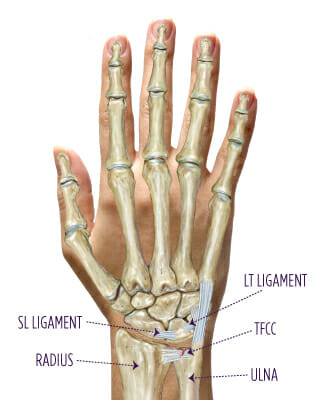What is Wrist Arthroscopy?
Arthroscopy is a surgical procedure that allows your hand specialist to get to the inside of your joint through several tiny incisions. Your specialist can confirm your diagnosis and repair any injured ligaments, tendons, and bones by using a camera and tools inserted into the joint space.
How is it performed?
Two or more small incisions are made where the surgical tools are inserted. The first tool is a small fiberoptic camera that lets your specialist see the injury and confirm your diagnosis. The second tool is inserted into the wrist and allows the specialist to perform the surgery and repair your wrist. The third tool brings sterile fluid to the area and expands the joint so that it can be more easily seen.
How did my specialist diagnose it?
The ligament tear was diagnosed by an MRI and physical examination.
What can I expect before surgery?
When you are ready to have surgery, you will need to talk with your specialist’s patient coordinator to schedule an appropriate time. He or she will provide you with the necessary paper work, talk to you about a preoperative physical, and help you with any questions you may have.
A preoperative physical is required prior to surgery. If you do not have this done, your surgery may have to be canceled and rescheduled. Any questions about this can be directed to your specialist’s patient coordinator.
What can I expect after surgery?
Immediately after surgery, you will be brought to a recovery room and monitored by a nurse. You can expect your wrist to be bandaged and possibly immobilized. After you are awake and alert, a nurse will help you get ready to go home. It is necessary for you to arrange for someone to receive your after-surgery instructions and drive you home, because the sedation will make driving unsafe.
While at home, you should rest, ice, and elevate the wrist to prevent excessive swelling and pain. Each surgery requires different periods of immobilization, dressing changes, and wound care. Your specialist will discuss the specifics of your postoperative recovery with you prior to surgery. Follow the instructions. And if you have any questions or concerns, contact your specialist’s office for clarification.
Additionally, medication will be prescribed to you for the postoperative pain. It is your responsibility to have the prescription filled. Prior to surgery, your specialist’s patient coordinator will schedule a postoperative visit, where you will discuss physical therapy and further activity guidelines.
What are the risks?
As with any surgery, arthroscopy has risks. These include, but are not limited to, swelling and stiffness, infection, and damage to nerves and tendons. The American Society for Surgery of the Hand has cited this risk to be typically less than 1 percent. By following your specialist’s instructions and remaining in good communication, these risks can be minimized.
How long is recovery?
The length of your recovery depends on the procedure performed. You can talk with your hand specialist regarding your specific situation and recovery plan.


